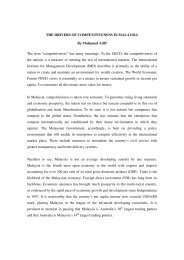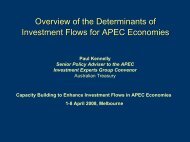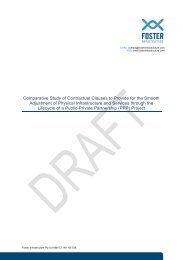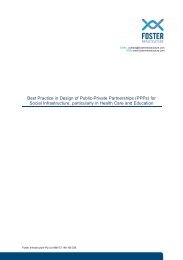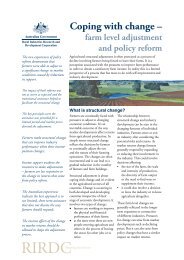Comparative Study of Contractual Clauses to Provide for the Smooth ...
Comparative Study of Contractual Clauses to Provide for the Smooth ...
Comparative Study of Contractual Clauses to Provide for the Smooth ...
- No tags were found...
You also want an ePaper? Increase the reach of your titles
YUMPU automatically turns print PDFs into web optimized ePapers that Google loves.
<strong>Comparative</strong> <strong>Study</strong> <strong>of</strong> <strong>Contractual</strong> <strong>Clauses</strong> <strong>for</strong> <strong>the</strong> <strong>Smooth</strong> Adjustment <strong>of</strong>Physical Infrastructure and Services through <strong>the</strong> Lifecycle <strong>of</strong> a PPP ProjectAugust 20123 Background – The Need <strong>for</strong> Flexibility in PPPsA potential criticism <strong>of</strong> PPPs is that <strong>the</strong>y do not provide long-term flexibility and can imposesignificant costs on government if <strong>the</strong>re is a need <strong>to</strong> modify <strong>the</strong> physical infrastructure orvary <strong>the</strong> services provided by <strong>the</strong> private party at some point during <strong>the</strong> life-cycle <strong>of</strong> <strong>the</strong>project. This risk has been widely recognised 1 :Several recent reports on PPP contracting highlight <strong>the</strong> need <strong>for</strong> enhanced contractualflexibility, in particular aimed at taking in<strong>to</strong> account possible changes in user needsthat – in <strong>the</strong> presence <strong>of</strong> rigid contracts – have sometimes triggered very costlycontract renegotiation processes. Enhanced flexibility, in particular directed <strong>to</strong>accommodate changes in user needs, is important <strong>for</strong> <strong>the</strong> long-term projects typical <strong>of</strong>PPP, and may be achievable through well designed change-management contractualclauses necessary <strong>to</strong> limit potential abuses. However, enhanced flexibility willinevitably come at <strong>the</strong> cost <strong>of</strong> lower predictability and higher risk <strong>for</strong> <strong>the</strong> investingprivate-sec<strong>to</strong>r party, and <strong>of</strong> reduced effectiveness <strong>of</strong> <strong>the</strong> competitive selection process.3.1 Why does government need flexibility in PPPs?The need <strong>for</strong> flexibility <strong>to</strong> implement variations in a PPP typically arises due <strong>to</strong> one <strong>of</strong> <strong>the</strong>following causes 2 :1. government wishes <strong>to</strong> implement a new policy initiative2. government’s project-specific needs change.Examples <strong>of</strong> variations arising as a result <strong>of</strong> government wishing <strong>to</strong> implement a new policyinitiative include changing food standards, which may require a variation <strong>to</strong> <strong>the</strong> cateringservices provided by <strong>the</strong> private party in a social infrastructure PPP, and changes in roadsurfacing standards, which may require a variation in <strong>the</strong> private party’s maintenanceobligations in a highway PPP project. Some policy initiatives are enacted in legislation, andtake effect through <strong>the</strong> “change in law” clause in a PPP contract, ra<strong>the</strong>r than beingimplemented as a variation. “Change in law” clauses are discussed in section 4.2.1 below.Examples <strong>of</strong> variations arising as a result <strong>of</strong> a change in government’s project-specific needsinclude installing additional electrical sockets in a government operated school or hospital <strong>to</strong>enable government <strong>to</strong> use additional equipment in <strong>the</strong> building, and altering cells in a prisonPPP <strong>to</strong> enable <strong>the</strong> prison <strong>to</strong> accommodate different categories <strong>of</strong> prisoners.3.1.1 The need <strong>for</strong> flexibility in Economic Infrastructure PPPsIn economic infrastructure PPPs, such as those in <strong>the</strong> roads and water sec<strong>to</strong>rs, variationsmost commonly arise because <strong>the</strong> PPP <strong>for</strong>ms part <strong>of</strong> a wider infrastructure network. Whengovernment seeks <strong>to</strong> make improvements <strong>to</strong> <strong>the</strong> wider network, variations <strong>to</strong> <strong>the</strong> PPPcomponent may be necessary <strong>to</strong> ensure that <strong>the</strong> network as a whole operates effectivelyand efficiently. Such changes may be relatively infrequent, but can be important <strong>to</strong> maximise1 Iossa, Spagnolo and Velez, “Contract Design in Public-Private Partnerships – Report prepared <strong>for</strong><strong>the</strong> World Bank” (September 2007), page 57. (Available athttp://www.gianca.org/PapersHomepage/Contract%20Design.pdf.)2 See National Audit Office, “Making Changes in Operational PFI Projects” (17 January 2008), page 9.(Available at http://www.nao.org.uk/publications/0708/making_changes_operational_pfi.aspx.)Page 10 <strong>of</strong> 35Foster Infrastructure




